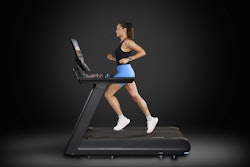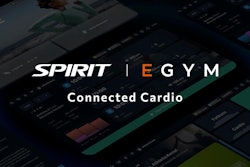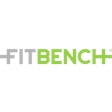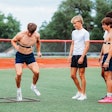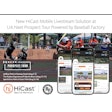Source: National Athletic Trainers' Association
In 2015, 50 high school athletes lost their lives during sports or physical activity. Thousands of student athletes develop acute and long-term injuries as a result of participation. Research shows that many of these deaths and conditions could be avoided if best practices were in place.
Please join the National Athletic Trainers’ Association (NATA) and American Medical Society for Sports Medicine (AMSSM) for the Second Collaborative Solutions for Safety in Sport press conference: sharing best practices for improving and implementing safety in high school sports.
Sports medicine leaders will present new research, recent successes and challenges pertinent to sports health. A new study, “Implementing Health and Safety Policy Changes at the High School Level from a Leadership Perspective” and an accompanying commentary, “Sport Safety Policy Changes Save Lives and Protect Athletes,” will be advance released that morning and published in the April issue of the Journal of Athletic Training, NATA’s scientific publication.
Following the press conference, NATA and AMSSM with the support of Gatorade, Korey Stringer Institute, NCAA, National Federation of State High School Associations and Sanford Health, will bring together sports medicine and high school sports representatives in secondary school athletics from all 50 states to discuss these initiatives and improve safety in youth sports for an intensive two-day meeting.
Last year, key stakeholders from every state attended with a call to action that all high schools have emergency action plans in place.
Policies by the numbers (and percent improvements since the 2014-15 school year):*
- Emergency action plans: 28 percent of states meet the recommendation that every school or organization that sponsors athletics develop an EAP for managing serious or potentially life-threatening injuries: a 6 percent improvement.
- Concussions: 44 percent of states require that a graduated return-to-play protocol consisting of at least five steps with no more than two steps occurring on one day is implemented for athletes returning back to activity from a concussion: a 24 percent improvement.
- Heat acclimatization: 48 percent of states meet the recommendation that total practice time should not exceed three hours in any one day: a 20 percent improvement. And, 62 percent of states meet the recommendation that all schools have a heat modification policy: a 20 percent improvement.
*Recommendations are based on current, evidence-based best practices.
YET:
- Only 50 percent of states meet the recommendation that all athletic trainers, coaches, administrators, school nurses and physical education teachers have access to an automated external defibrillator (AED) on school property and at all school sanctioned athletic events/activities.
- Only 12 percent of states meet the recommendation that every school has a written EAP that is distributed to all staff members.
- Only 15 states currently meet evidence-based minimum heat acclimatization best practices.
Speakers:
Douglas Casa, PhD, ATC, FNATA, chief executive officer, Korey Stringer Institute, University of Connecticut
How policy promotes change: Sport safety policy changes save lives and protect athletes (April 2016 Journal of Athletic Training commentary)
Cindy J. Chang, MD, associate professor, UCSF Sports Medicine; chair, Sports Medicine Advisory Committee, California Interscholastic Federation (CIF); past AMSSM president
Role of the team physician: The day to day challenges of implementing change
Brian Hainline, MD, chief medical officer, NCAA
Health and welfare of the student athlete from high school to college
William Heinz, MD, chair, Sports Medicine Advisory Committee, National Federation of State High School Associations (NFHS)
NFHS perspective: Enhancing policy change
Nick Inzerello, senior director, Football Development, USA Football
Heads Up Football High School: Improved coaching education and medically endorsed standards
Kelly Pagnotta, PhD, ATC, PES, assistant professor of Athletic Training, Temple University
Health and safety policy changes at the high school level from a leadership perspective (April 2016 Journal of Athletic Training study)
Denise Alosa, ATC, Sports Medicine Advisory Committee member, Vermont Principals’ Association
Grassroots success: Vermont best practices
CONTACT:
Robin Waxenberg, 212/489-8006, [email protected]
About NATA: National Athletic Trainers’ Association (NATA) – Health Care for Life & Sport
Athletic trainers are health care professionals who specialize in the prevention, diagnosis, treatment and rehabilitation of injuries and sport-related illnesses. They prevent and treat chronic musculoskeletal injuries from sports, physical and occupational activity, and provide care for acute injuries. Athletic trainers offer a continuum of care that is unparalleled in health care. The National Athletic Trainers’ Association represents and supports 43,000 members of the athletic training profession. Visit www.nata.org
About AMSSM: American Medical Society for Sports Medicine (AMSSM) is a multi-disciplinary organization of 3,000 sports medicine physicians dedicated to education, research, advocacy and the care of athletes of all ages. The majority of AMSSM members are primary care physicians with fellowship training and added qualification in sports medicine who then combine their practice of sports medicine with their primary specialty. AMSSM includes members who specialize solely in non-surgical sports medicine and serve as team physicians at the youth level, NCAA, NFL, MLB, NBA, WNBA, MLS and NHL, as well as with Olympic teams. By nature of their training and experience, sports medicine physicians are ideally suited to provide comprehensive medical care for athletes, sports teams or active individuals who are simply looking to maintain a healthy lifestyle. Visit www.amssm.org


















